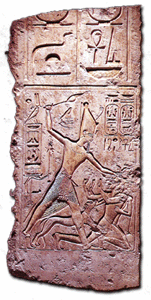
|
|
|
|
|
|
|
Among the most impressive material in the University of Pennsylvania Museum's (UPM) Egyptian collection are architectural fragments from the ceremonial palace of the Pharaoh Merenptah from the site of Memphis (Dynasty 19, ca. 1213-1203 B.C.). These elements include several columns, lintels, and enormous gateways measuring over twenty feet high at their full height. This monunmental structure was excavated by the Coxe Expedition in 1914-18. The Merenptah Palace is completely unique, not only in the United States but worldwide. No other museum outside of Egypt itself possesses such massive remains of an ancient Egyptian palace. Some additional features of the palace excavated by the Coxe Expedition are currently held in the Cairo Museum. The palace was built by Merenptah (one of the sons of King Ramses II) during his reign, which lasted from 1224-1204 B.C. Shortly after Merenptah's death, the palace burned and the stone elements such as columns, lintels, windows, doorjambs were left where they fell and were soon buried under debris. This accidental destruction preserved the stone elements. The palace consisted of a large courtyard, a throne room, and a private living quarter for the king. The total area covered by this complex was over two-thirds of an acre. At the present time, the architectural elements of the palace of Merenptah are on display in the Lower Egyptian Gallery at the UPM. Because of the relatively low ceiling height, the massive columns and doorjambs from the palace are displayed in two segments at half of their actual height. |
|
[top] |
|
|
|
|
|
|
Egypt
Home |
Expeditions Past and Present | Gallery
Tour | Gods and Goddesses |
